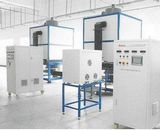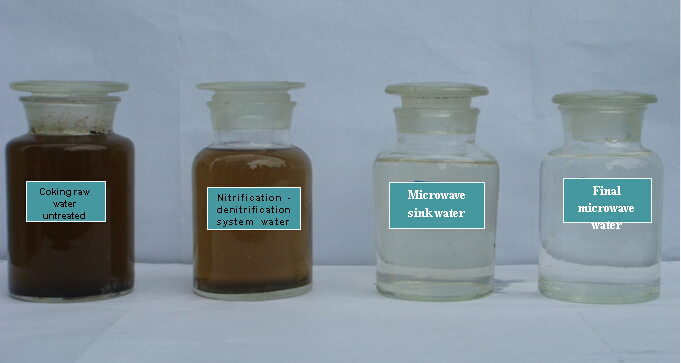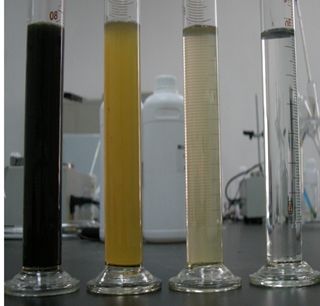Industrial wastewater treatment equipment with microwave technology


Industrial wastewater , such as high-concentration chemical sewage, coking waste water, municipal sewage , livelihood waste water and others can be treated by our microwave equipment as an advanced method.
With the aid of non-thermal effects of microwave and select absorbing “sensitizer”, microwave energy can be passed into water and induces pollutants to react, through series of physical and chemical reactions, pollutants are degraded and converted. And this process further promotes the separation between solid and liquid in water. The water after processing has no secondary pollution and can be reused.
The basic parameters:
| MWG2S | MWG6S | MWG20S
|
| Input voltage | 220+_5%V | 380+_5%V | 380+_5%V |
| Power of microwave | 2KW | 6KW | 20KW |
| Frequency of microwave | 2450+_50MHZ | 2450+_50MHZ | 915+_50MHZ |
| Size | 1m*0.8m*1m | 1.2m*1.7m*2.1m | 1.76m*1.76m*3.4m |
| Treating capacity | 1m3/h | 10m3/h | 100m3/h |
| Continuous working time | >4h | >24h | >24h |
|  |  |  |
Note:Leakage of microwave:<=5mw,material of cover:carbon steel with powder coating
Effect showing:
1.Coking wastewater treatment

Project tested
| Raw
water
| Microwave
water
| Treatment efficiency
(%)
| National standard
(GB16171-2012)
|
pH
| 7.52
| 7.96
| | 6-9
|
COD(mg/L)
| 193
| 35
| 82
| 100
|
BOD5(mg/L)
| 30
| 3
| 90
| 25
|
Ammonia (mg/L)
| 4.2
| 2.8
| 33
| 15
|
Total phosphorus (mg/L)
| 1.66
| 0.04
| 98
| 1.50
|
Suspended solids (mg/L)
| 143
| 17
| 88
| 70
|
Volatile phenol (mg/L)
| 0.28
| 0.05
| 82
| 0.50
|
Cyanide (mg/L)
| 0.37
| 0.22
| 41
| 0.20
|
Sulfide (mg/L)
| 0.37
| 0.29
| 22
| 1.0
|
Petroleum (mg/L)
| 3.84
| 0.60
| 84
| 5.0
|
2.Pig farm sewage treatment
Pig farm sewage treatment by microwave chemical method.the water samples of various stages as below:

raw water/ Pretreatment / Intermediate System water / Microwave system water
| Project tested | Raw water
| Microwave water
| Treatment efficiency
(%)
| National standard
(GB18596-2001)
|
PH
| 7.75
| 7.79
| | 6-9
|
COD(mg/L)
| 3950
| 80
| 98
| 400
|
BOD5(mg/L)
| 800
| 50
| 88
| 150
|
Ammonia (mg/L)
| 345
| 30
| 91
| 80
|
Suspended solids (mg/L)
| 1200
| 110
| 91
| 200
|
Quantity of colon bacillus in dung (pcs/L)
| 3000
| 500
| 83
| 1000
|
3.Hospital wastewater treatment
Project tested
| Raw water
| Microwave water
| Treatment efficiency
(%)
| National standard
(GB18466-2005)
|
PH
| 7.75
| 7.79
| | 6-9
|
COD(mg/L)
| 199
| 21
| 89
| 60
|
BOD5(mg/L)
| 120
| 12
| 90
| 20
|
| Ammoniacal nitrogen(mg/L) | 45.2
| 8.6
| 81
| 15
|
Animal and vegetable oils
| 1.25
| 0.07
| 94
| 5 |
oil
| 0.28
| 0.04
| 86
| 5
|
LAS
| 1.32
| 0.05
| 96
| 5
|
chroma(times)
| 11
| 2
| 82
| 30
|
Suspended solids
| 115
| 19
| 83
| 20
|
Quantity of colon bacillus in dung (pcs/L)
| 1000
| 300
| 70
| 500
|
System composition:
The equipment is composed of a microwave generator and microwave cavity.
Feature:
1.Microwave energy wastewater treatment technology could make the treatment project of wastewater miniaturization (small footprint, equivalent to 1/10—1/30 of traditional ones), meanwhile, it has other features such as short process, decentralization and short construction period and saves engineering of burying long distance network of blow-off pipe lines in existing wastewater treatment project and blocks the sources of pollution, which fundamentally eliminate pollution in rivers or lakes caused by human life and production activities.
2.It has features of low investment intensity and overall energy consumption and operating costs for unit of sewage treatment.Set an example of urban wastewater, the processing cost is about 0.8 RMB per ton compared to 1.4—1.6 RMB in common way.
3.It can purify a variety of municipal sewage and industrial waste water and it not affected by ambient temperature and concentration of waste water or pollutants.
4.It has good water processing result and its course can be free to control according to requirement. In addition, because microwave has special action of killing blue-green algae, it can completely remove contaminants and kill pathogens in sewage.
5.In order to achieve the sustainable use of water resources and sewage this equipment can convert the polluted water in rivers or lakes into safe green ones which can be used in industry and agriculture.
6.Microwave can handle benzene and phenol in high concentrations sewage to meet emission standards.
7.It can do deep treatment for high concentration sewage with poor biochemical.
8.It has fast sedimentation of flocculation and improves breaking effectiveness.
9.Miniaturized microwave sewage treatment system.
10.In order to reduce pollution, improve the environment, achieve recycling economy and water reuse and meet better practical requirements, this device can be combined with a variety of traditional methods such as chemical methods and membrane technology.
Related Items







